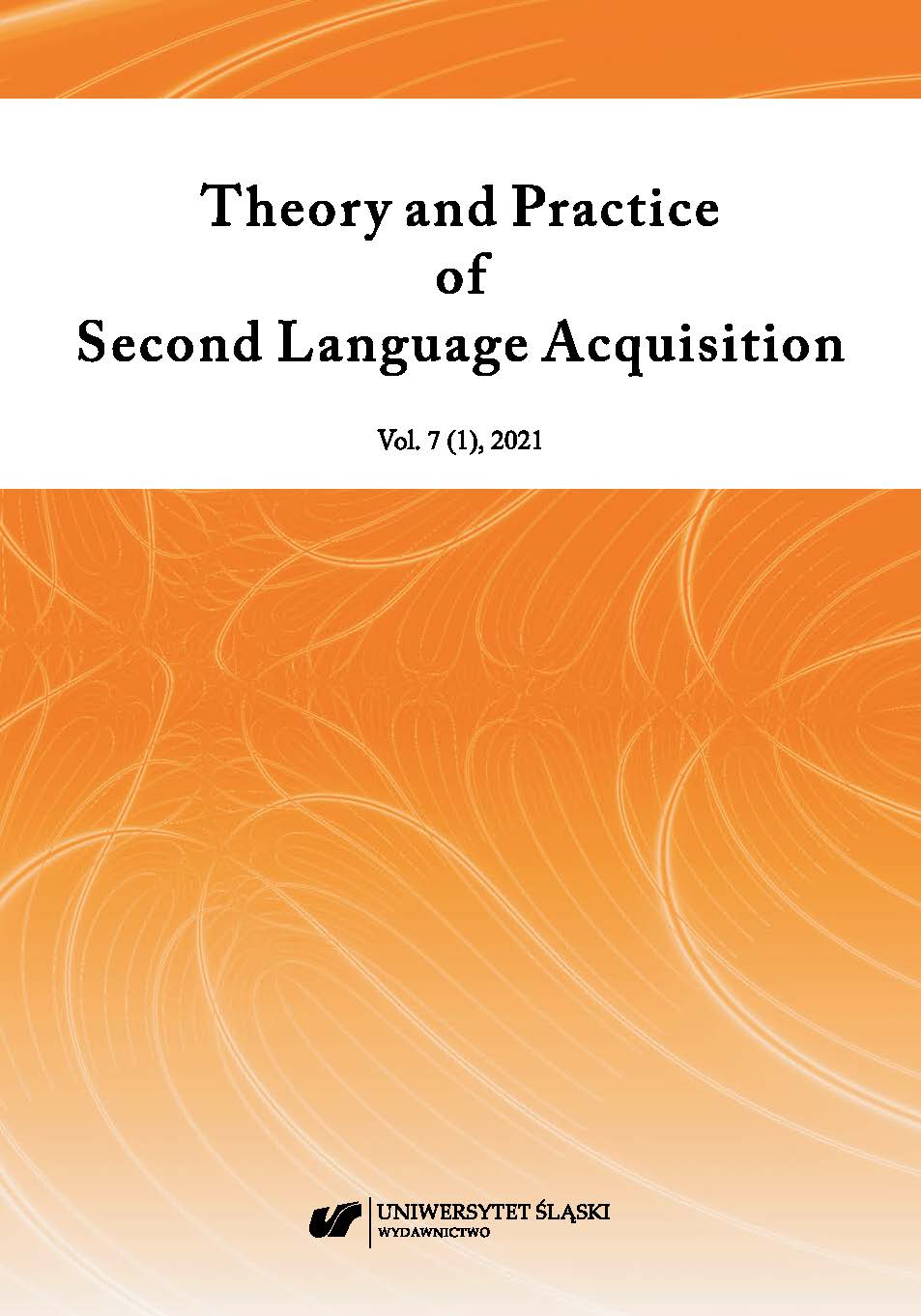Aranoff, M., & Rees-Miller, J. (2003). The Handbook of Linguistics. Blackwell Publishers: Oxford.
Google Scholar
Backus, Ad. (2001). The role of semantic specificity in insertional codeswitching: Evidence from Dutch-Turkish. In Jacobson, R. (Ed.), Codeswitching Worldwide II (pp.125–154). Berlin: Mouton de Gruyter.
Google Scholar
Blom, J., & Gumperz, J. (2001 [2000]). Social Meaning in Linguistic Structure. Code-Switching in Norway. In Wei, L. (Ed.), The Bilingualism Reader (pp.111–126). London: Routledge.
Google Scholar
Błasiak, M. (2011). Dwujęzyczność i Ponglish: zjawiska językowo-kulturowe polskiej emigracji w Wielkiej Brytanii. Kraków: Collegium Columbinum.
Google Scholar
Boztepe, E. (2003). Issues in code-switching: Competing theories and models. Working Papers in TESOL & Applied Linguistics, 3(2), 1–27.
Google Scholar
Bullock, B. E., & Toribio, A. J. (2009). Themes in the study of code-switching. In Bullock, B. E., & Toribio, A. J. (Eds.), The Cambridge Handbook of Linguistic Code-switching (pp. 1-17). Cambridge: Cambridge University Press.
Google Scholar
Chalker, S., & Weiner, E. (1994). The Oxford Dictionary of English Grammar. Oxford: Clarendon Press.
Google Scholar
Crystal, D. (2008). A dictionary of linguistics and phonetics (6th ed.). Malden: Blackwell.
Google Scholar
Diki. Multimedialny słownik angielskiego online. Retrieved September 1, 2019 from http://www.diki.pl/.
Google Scholar
Esen, S. (2014). Code Switching: Definition, Types, and Examples. Retrieved September 2, 2019, from https://owlcation.com/humanities/Code-Switching-Definition-Types-and-Examples-of-Code-Switching.
Google Scholar
Gabryś-Barker, D. (2007). Zjawisko wtrąceń z języka drugiego u osoby dwujęzycznej: charakterystyka i funkcje. In Chłopicki, W. (Ed.), Komunikacja międzykulturowa; perspektywy badań interdyscyplinarnych, (pp. 293–305). Kraków: Wydawnictwo Tertium.
Google Scholar
Gardner- Chloros, P. (1987). Code-switching in relation to language contact and convergence. In Lüdi, G. (Ed.), Devenir bilingue-parler bilingue; actes du 2ème colloque sur le bilinguisme, (pp. 99–115). Tübingen: Niemeyer.
Google Scholar
Gardner-Chloros, P. (1995). Code-switching in community, regional and national repertoires: the myth of the discreteness of linguistic systems. In Milroy, L., & Muysken, P. (Eds.), One speaker, two languages (pp. 68–90). Cambridge: Cambridge University Press.
Google Scholar
Gardner-Chloros, P. (2011 [2009]). Code-switching. Cambridge: Cambridge University Press.
Google Scholar
Gonzalez, J. (Ed.). (2008). Encyclopedia of bilingual education. California: SAGE Publications, Inc.
Google Scholar
Halmari, H. (1997). Government and codeswitching: Explaining American Finnish. Amsterdam: John Benjamins.
Google Scholar
Hamada, M. (2012). A Facebook Project for Japanese University Students: Does It Really Enhance Student Interaction, Learner Autonomy, and English Abilities? In Bradley, L., & Thouësny, S. (Eds.), EUROCALL Conference Proceedings: Using, Learning, Knowing (pp. 104–110). Dublin-Voillans: Research-publishing.net.
Google Scholar
Grosjean, F. 2008. Studying Bilinguals. Oxford: Oxford University Press.
Google Scholar
Haspelmath, M. (2008). Loanword typology: Steps toward a systematic cross-linguistic study of lexical borrowability. In Stolz, T., Bakker, D., & Salas Palomo, R. (Eds.), Aspects of language contact: New theoretical, methodological and empirical findings with special focus on Romancisation processes (pp. 43–62). Berlin and New York: Mouton de Gruyter.
Google Scholar
Haugen, E. (1956). Bilingualism in the Americas: A Bibliography and Research Guide. Alabama: University of Alabama Press.
Google Scholar
Hoffman, Ch. (1991). An introduction to bilingualism. New York: Longman.
Google Scholar
Jedamska, K. (2015). Portale społecznościowe – nowe narzędzie komunikacji politycznej. Retrieved September 1, 2019 from http://apcz.umk.pl/czasopisma/index.php/TEST_UMK/article/view/5866.
Google Scholar
Le Page, R. B., & Tabouret-Keller, A. (1985). Acts of identity: Creole-based approaches to ethnicity and language. Cambridge: Cambridge University Press.
Google Scholar
MacSwan, J. (1997). A Minimalist Approach to Intrasentential Code Switching: Spanish-Nahuatl Bilingualism in Central Mexico (Doctoral dissertation). Los Angeles: University of California. Retrieved September 1, 2019, from http://www.public.asu.edu/~macswan /diss.html.
Google Scholar
Manfredi, S., Simeone-Senelle, M. C., & Tosco, M. (2015). Language contact, borrowing and codeswitching. In Mettouchi, A., Vanhove, M., & Caubet, D. (Eds.), Corpus-based Studies of lesser-described Languages: the CorpAfroAs Corpus of spoken AfroAsiatic languages. Studies in Corpus Linguistics 67 (pp. 283–308). Amsterdam: John Benjamins.
Google Scholar
Muysken, P. (1997). Code-switching processes: Alternation, insertion, congruent lexicalization. In Pütz, M. (Ed.), Language choices: Conditions, constraints, and consequences (pp. 361–380). Amsterdam and Philadelphia: John Benjamins.
Google Scholar
Muysken, P. (2000). Bilingual Speech: A Typology of Code-Mixing. Cambridge: Cambridge University Press.
Google Scholar
Myers-Scotton, C. 1993. Social motivations for codeswitching. Evidence from Africa. Oxford: Clarendon Press.
Google Scholar
Pahta, P. (2004). Code-switching in Medieval English Medical Writing. In Taavitsainen, I., & Pahta, P. (Eds.), Medical and Scientific Writing in Late Medieval English (pp. 73–99). Cambridge: Cambridge Univeristy Press.
Google Scholar
Panocová, R. (2015). Categories of Word formation and Borrowing. An Onomasiological Account of Neoclassical Formations. Newcastle upon Tyne: Cambridge Scholars Publishing.
Google Scholar
Author, D. (2019). Hejting, trolling i unboxing – o współczesnym wpływie języka angielskiego na język polski używany na Facebooku. In Welskop, W., & Tanaś, V. (Eds.), Mass media we współczesnym świecie (pp.113–123). Łódź: Wydawnictwo Naukowe WSBiNoZ.
Google Scholar
Pfaff, C. W. (1979). Constraints on Language Mixing: Intrasentential Code-Switching and Borrowing in Spanish/English. Language, 55(2), 291–318.
Google Scholar
Poplack, S. (1980). Sometimes I'll start a sentence in Spanish y termino en espa ol: toward a typology of code-switching. Linguistics, 18(7/8), 581-618.
Google Scholar
Poplack, S. (1981). Syntactic Structure and Social Function of Codeswitching. In Duran, R. P. (Ed.), Latino Language and Communicative Behaviour (pp. 169–184). New Jersey: Ablex Publishing Corporation.
Google Scholar
Poplack, S. (2004). Code-switching. In Ammon, U., Dittmar, N., Mattheier, K.J. & Trudgill, P. (Eds.), Sociolinguistics/Soziolinguistik: An international handbook of the science of language (pp. 589–596). Berlin: Walter de Gruyter.
Google Scholar
Romaine, S. (1995). Bilingualism. Oxford: Blackwell Publishers.
Google Scholar
Schmidt, A. (2014). Between The Languages: Code-Switching in bilingual communication. Hamburg: Anchor Academic Publishing.
Google Scholar
Skowron-Nalborczyk, A. (2003). Zachowania językowe imigrantów arabskich w Austrii. Warszawa: Wydawnictwo Akademickie Dialog.
Google Scholar
Walid, R. M. (n.d.). Why do People Code Switch: A Sociolinguistics Approach. Arab Open University. Retrieved August 22, 2019, from http://www.academia.edu/2649532/Why_do_People_Code-switch_A_Sociolinguistic_Approach.
Google Scholar
Wielki slownik języka polskiego. Retrieved September 1, 2019 from https://www.wsjp.pl.
Google Scholar
Zabawa, M. (2012). English lexical and semantic loans in informal spoken Polish. Katowice: Wydawnictwo Uniwersytetu Śląskiego.
Google Scholar


 https://doi.org/10.31261/TAPSLA.7791
https://doi.org/10.31261/TAPSLA.7791

 10.31261/tapsla
10.31261/tapsla